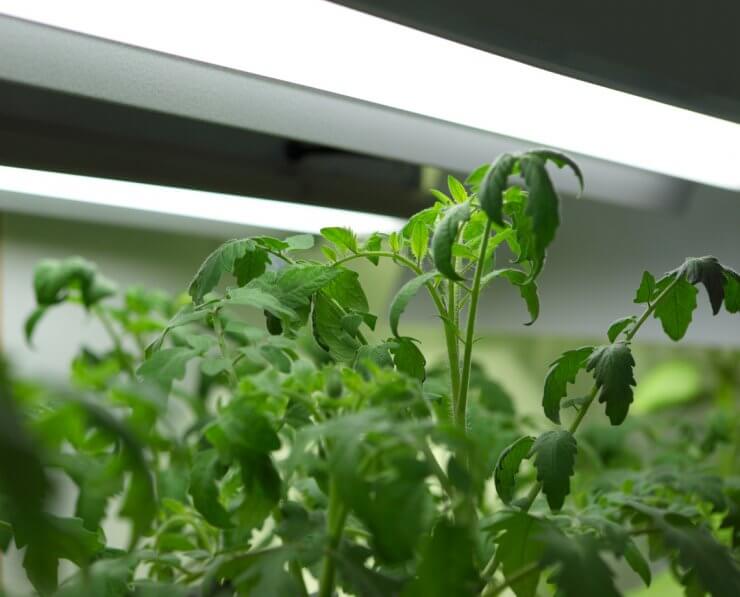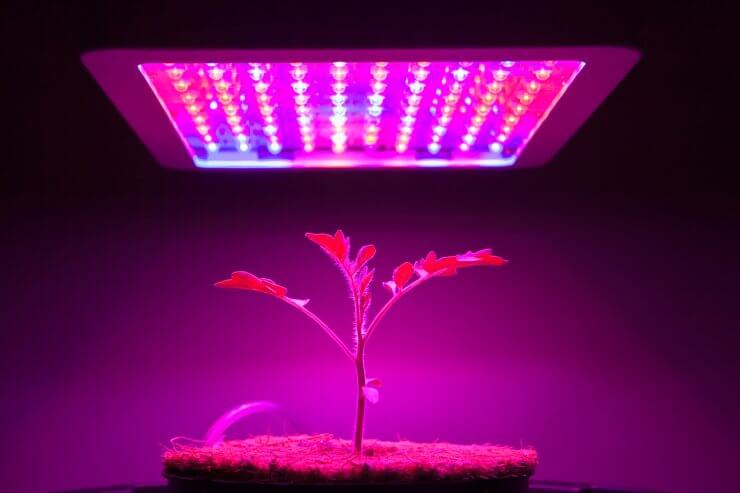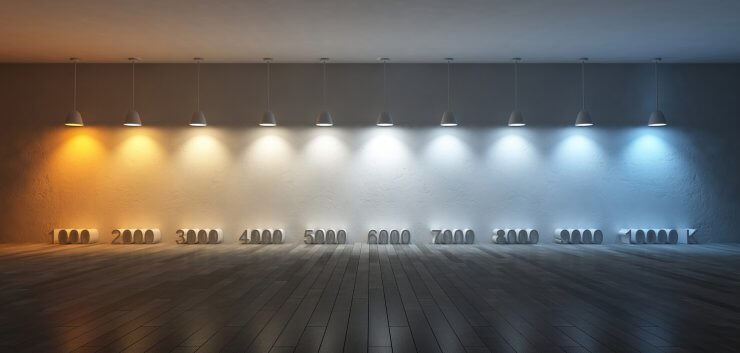
Living in New England, my outdoor garden slows to a halt by late September. I used to get sad thinking about how long I’d have to wait before growing another crop of fresh tomatoes and peppers. (Is there anything worse than a grocery store tomato in January?) Then I decided I would try my hand at indoor growing, so I could enjoy fresh tomatoes and peppers all year long. At first, I experimented with hydroponic grow kits, some with built-in grow lights. Now my set-up includes both hydroponic and soil methods. Even in my sunniest room, my indoor tomatoes and peppers require supplemental light. Through trial, error, and research, I’ve discovered the best grow lights for tomatoes and peppers.
Regardless of location, tomatoes and peppers need six to eight hours of sunlight (artificial or natural) each day.
Grow lights are generally safe to be 12″ or more from your seedlings when they are first starting out. 12″ is usually the distance I keep for any general-use full-spectrum LED grow light. After a few weeks when they are stronger and have a root system, you can move them closer as needed.
To get that 12″ (or more), there are various structures and rigs you can assemble for your indoor tomato and pepper plants. You can even opt to just use your indoor system to start your tomato and pepper seeds and eventually move the seedlings outside when the weather warms up. Whatever you decide, the most important element for growing your indoor tomatoes and peppers is choosing the best grow lights.
Discover 7 top tips for growing, harvesting, and enjoying tomatoes from your home garden—when you access the FREE guide The Best Way to Grow Tomatoes, right now!
Types of grow lights
There are a few different categories of grow lights, each with its own benefits. Note: I’m not including incandescent lights (standard home-use lightbulbs) in this list because they aren’t a preferred choice for growing vegetables as they end up producing more heat than light.
CFL (Fluorescent)
CFL grow lights are generally a bit cheaper to purchase. However, most fluorescent lights won’t give off full spectrum light deep into tomato and pepper plants, and you’ll wind up with a smaller yield of tomatoes and peppers. The CFL grow lamp featured here can be found on Amazon.
Suggestions:
HID (high-intensity discharge)
There are two subcategories in the HID type of grow light (HPS – high-pressure sodium; MH – metal halide) and you need to use both kinds at different stages of a plant’s growth cycle. These lights are very powerful and require specific rigging and fixtures. The HID bulbs need to be replaced more frequently adding to the cost. These are great bulbs for a professional or semi-professional set-up, but for growing tomatoes and peppers at home, I don’t recommend starting here, but the setup featured above is available on Amazon.
Suggestions:
- HTG Supply 250W (3×3′ coverage)
- VIVOSUN 400W HPS (400 watt)
- Hydro Crunch 1000W (1000 watt)

Full-Spectrum LED
Saving the best for last, full-spectrum LED grow lights are more cost-efficient in the long run since they use the least amount of power and they are safer because they don’t produce the hot surface temperatures like other types of lights. Beyond being energy-saving, the light wavelengths are fuller which will yield more tomatoes and peppers per plant. This is my recommendation for the best grow lights for growing tomatoes and peppers in a home set-up. I also really like that these lights are fully integrated and don’t require purchasing and replacing extra bulbs. These are the bulbs my hydroponic setup uses too.
Suggestions:
- VIPARSPECTRA LED Grow Light (3×3’ coverage)
- Spider Farmer SF-2000 LED Grow Light (3×4′ coverage)
What to look for in grow lights for tomatoes and peppers
When I first started researching different types of grow lights, my head spun! I wasn’t familiar with many of the terms used and thought I was decoding a secret language. Here are a few terms you might run into when shopping for the best grow lights:

Full-spectrum
In grow-light marketing terms, “full-spectrum” means the light can reproduce the effects of sunlight on plants. For tomatoes and peppers, using a “full-spectrum” light is a must and full-spectrum LED lights are, in my opinion, the best.
Heat sink
A heat sink is a part of a light fixture (most often found in LED lights) that increases the heat flow away from the hot light. While not necessary, a heat sink is an important feature that will prevent too much heat from being cast onto your plants causing them to dry out faster. A heat sink also improves a grow light’s longevity.

K value
For lighting purposes, the K (Kelvin) value is the scientific measure of the color of light. Values over 5000 are white and higher numbers even give off a blue tint. 4000K is more of a neutral off-white, and lower numbers in the 3000K range are tinted yellow/brown. In terms of growing tomatoes and peppers, grow lights that are similar to natural sunlight (something in the 6000K range) are best.
Our somewhat official list of the best grow lights
No list is ever complete, so let me explain some of the thought process that went into the selections here. I’m not a commercial grower, so I’m sticking with home-use lights here. I’m also sticking with LED lights, as they are generally less expensive and safer to operate and they’re easier to find in the full-spectrum range. Basically, I want something I can plug in and not worry too much about. With that in mind, here we go:
- ViparSpectra XS1500: This recently updated ViparSpectra light has a lot going for it – high-efficiency Samsung LED lights, high-tech Mean Well Driver to power the unit, a state-of-the-art heat sink to aid in cooling, and a dimmer you can adjust to coincide with the growth stage of your vegetables. It comes with a hanging kit, including ratchet hangers so you can adjust the height of the light (an important factor as your plants grow). The cons? You will still need hooks or a bar from which to hang the light. And there is no timer, so it will be up to you to turn the light on and off. Aside from that, however, this is pretty much a plug-and-play setup. At the time of publication, the ViparSpectra XS1500 retails for around $160.
- Black Dog LED PhytoMax-3 2SP: Black Dog LED designs and manufactures an array of commercial and home-use grow lights. To be clear, the focus of Black Dog is equipment for growing marijuana. However, the PhytoMax-3 2SP is a stellar grow light for indoor gardening. In addition to a full-spectrum of visible light, the LEDs offer some light in the UV and infrared ranges. The lights are daisy-chain compatible should you wish to expand at some point. These dimmable fixtures include long-life fans and an industry-leading heat sink. Additionally, these lights come with a 5-year warranty and a 90-day return policy. The downside? It’s not cheap. The PhytoMax-3 2SP retails for nearly $400 and you’re closing in on $800 for the next model up.
- Covert UFO 150 Watt Full-Spectrum LED Grow Light: Like the ViparSpectra, the Covert UFO light retails for around $160. And like the ViparSpectra, you only need a hook or bar from which to hang the light; otherwise you can just plug it in a go. With passive cooling, there are no fans or associated noise, but you may need to keep an eye on the heat output when your light is close to the plants.
In terms of size, tomatoes and peppers are high-light plants, and you’ll need about 40 watts per square foot for the best growth and production.
Grow Bigger, Better Tomatoes at Home
Tomatoes are the most popular plant for home gardeners! With our Tomato Gardening Guide, you’ll have everything you need to know about growing and enjoying this versatile food. From the history and background of the mighty tomato to specific advice about soil requirements and fertilizer … from watering techniques to details about avoiding tomato rot … from easy-to-make and delicious recipes that will allow you to enjoy the fruits of your gardening labor to the nutritional benefits of tomatoes—get it all in our Tomato Gardening Guide right now!
Do you grow tomatoes or peppers indoors? What grow lights work best for you? Let me know in the comments.
Note: Food Gardening Network contains links to affiliate websites including Amazon and Rakuten Affiliate Network and we may receive a commission for any eligible purchases made by you through links on this page.
Discover 7 top tips for growing, harvesting, and enjoying tomatoes from your home garden—when you access the FREE guide The Best Way to Grow Tomatoes, right now!





Just to add. I see folks talk about Lumens when buying a grow light. It is important to understand that lumens are a measure of how we (humans) perceive light and are not related to how plants absorb light. Many people look for color temperature (Kelvin) as the main factor when evaluating grow lights, however, Kelvin also only measures how light looks to the human eye— i.e. whether white light has a warmer or cooler color temperature to it. Color temperature tells us very little about the actual color spectrum distribution of a light, which is what actually impacts plant growth.
Humans and plants both “see” light with wavelengths between 400 nm (violet) and 700 nm (red). For plants, this region of light is called photosynthetically active radiation (PAR) and the unit of measure is micromoles of photons per second. Look for a PAR (photosynthetic active radiation) number, and you’ll be headed in the right direction when purchasing quality grow lights that will be the best for your plants.
Do you know what the 8 hour or monthly amount of Kilowatt hour usage is each LED listed unit uses?
Here is a link to a site that calculates LED energy usage. https://www.energybot.com/energy-usage/led-light-bulb.html
You can always copy and paste this post into a Word document in order to print it out. However, we’ve provided a more eco-friendly option – just click the Favorites button at the top of the page. This will save the post in the Favorites tab on the far right of the Navigation bar
Is there a way to print this information so that it can be referred to as often as needed?
What grow light would you recommend for seed starting vegetables?
I don’t need it for anything but getting them started early enough & keeping them strong (not leggy) prior to being able to plant them outside. Everything will be grown outdoors & I’m on a budget so I don’t want to invest in more than I need
Hello I start my tomatoes and peppers from my heirloom plants, actually I start all my plants from seed from last year on heat matts under my Full spectrum LED GROW LIGHTS, 1 is a Sonlipo 1200 LED GROW light 120w 3×3 ft coverage and Freelicht FL 1000 LED grow light with CREE@OSRAM led chips, 2×2 ft coverage, they both are linkable and have dimmer switches with no glass covers,with total heat dispation, so no burning ever happens at 12 inches,but honestly there’s so many full spectrum grow lights, just besure to look at the PPFD Map on the led grow lights to see what the colors put off at certain heights. Other than that ya can’t really go wrong, I’m not rich,I always get the knock-off stuff, using the rite soils n fertilizers is key with the full spectrum grow lights and Care,you’ll be successful. Love starting my garden plants from seed,then ya no what you got.ive had 3 hip surgeries and broken back so it’s relieving and stress reliever,I remember I started out with flood light and grow bulb and used a heating pad lol until I saved a few bucks to get heat mat @ thermostat, absolutely love doing It, already counting the days.me n my fiancee even start her flowers the same way.
I use the spider farmer sf300 and the seedlings emerge fast and healthy. I love this light and won’t use anything else.
Hi Guys, I’m using a ProGrow 200w led which I think is around 4000K and I keep it around 40cm from the top of 4 tomato plants. They grow so quickly using Thrive all purpose fertilizer at 3/4 strength solution
Hi sorry I agree. There are so many full spectrum LED’s out there
Perhaps a few actual examples. How far away for seedlings how many plants per light, what size light? How far away for mature plants? Nothing specific in this article and still have no idea what LED full spectrum to buy.
Thank you for your constructive comment, we recently updated the post to answer all of your questions!
Your title is “The best grow lights for tomatoes and peppers” but nowhere do you tell us what the best grow lights for tomatoes and peppers are! You compare and contrast bulb types but never say what’s best.
Sounds like LED ~ 6000k. I too expected something more specific. Most of the LEDs seem to come in 6500k or 5000k. I assume 6500k is better. However they always say 2700k for flowers and fruit.
I think you were pretty clear that LED is best and over 6000. I’m hoping to make a raised vegetable bed outdoors but have little sun. I’m hoping to hang a LED fixture over the bed on a timer and building a protective “roof” over it to protect it.
The cooler (red) IS important to get most plants to flower. Obvious if you want to grow fruit inside. The hotter (blue) end of the spectrum is all you need for roots and stem development. That’s my focus since I’m only starting plants indoors to beat the season. I use T5 versus T12 bulbs for the higher intensity initially. A 4’ light cost me $12 at Menards. I move them into 4” pots to grow/harden before setting out.
I hope you’ll find our recent update answers all your questions! Would also love to hear from other readers about what they use!
Actually, he did. The paragraph starts with “saved the best for last”, talking about the full spectrum lights, and links to purchase.